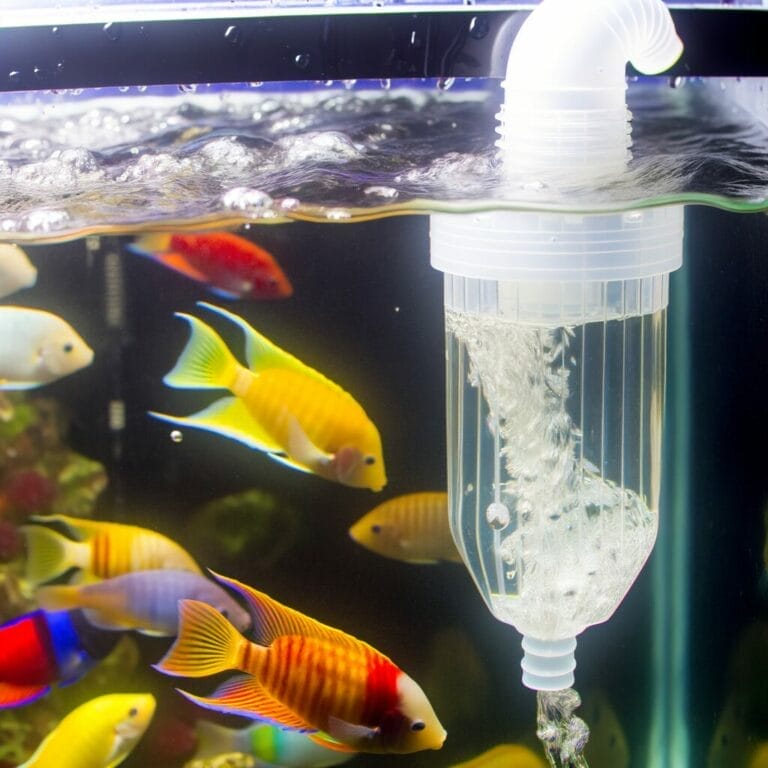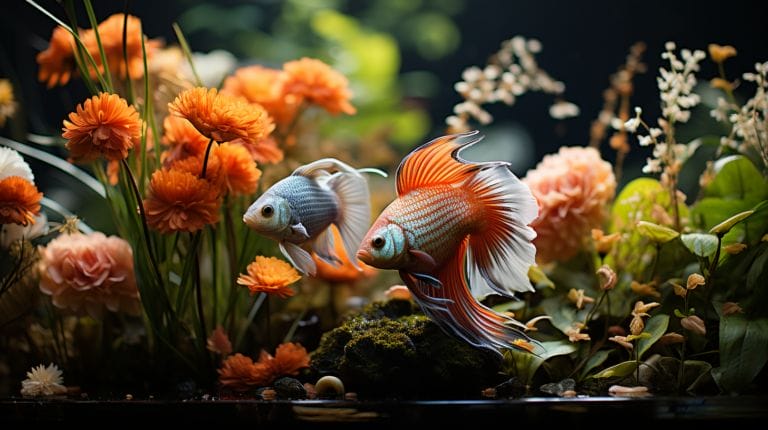How To Test Oxygen Levels In Aquarium: Aquarium Care Basics
Imagine the tranquil water in your aquarium, filled with vibrant fish and lush aquatic plants, suddenly turning into a suffocating environment.
As an aquarist, it’s essential that you maintain optimal oxygen levels to ensure the health and vitality of your underwater ecosystem. But how can you accurately measure these levels, and what steps can you take if they are not ideal?
In our ‘how to test oxygen levels in aquarium’ guide, you’ll discover the necessary tools and techniques, enlightening you on this fundamental aspect of aquarium care. So, are you ready to dive deeper into your role as the guardian of your aquatic pets?
Key Takeaways
- Testing oxygen levels in aquariums is crucial for the health of aquatic pets.
- Dissolved oxygen test kits are easily available and provide a quick overview of oxygen levels.
- Low oxygen levels in aquariums can be indicated by fish gasping at the surface, sluggish fish, plant decline, murkiness or unusual smells in the water.
- To maintain ideal oxygen levels, adhere to stocking guidelines, use cooler water for changes, increase water agitation, and regularly clean the aquarium.
Understanding Oxygen Levels in Aquariums
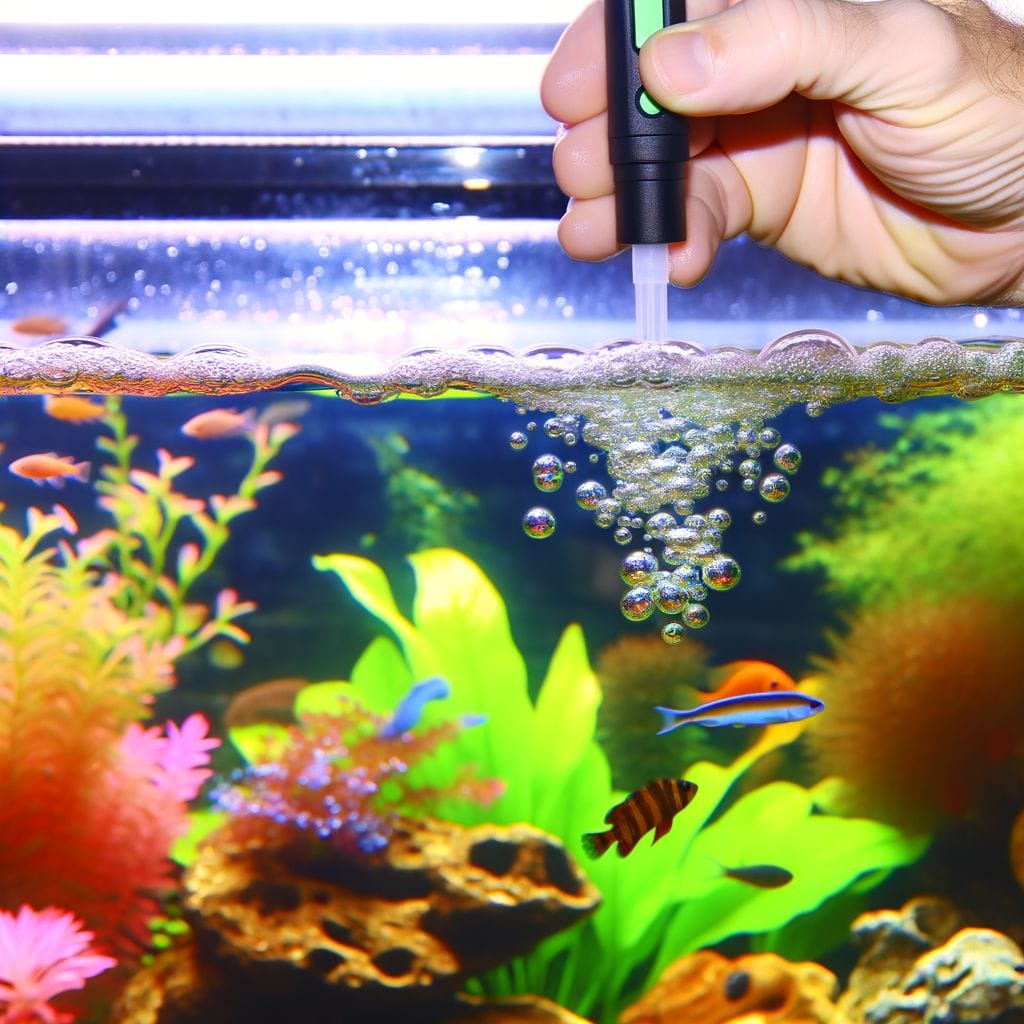
Before diving into the specifics, it’s vital to understand what ‘oxygen level in an aquarium’ means and why it’s so crucial for the health of your aquatic pets. Essentially, it’s all about dissolved oxygen, the invisible, life-giving gas that your fish and other water-dwelling creatures need to breathe. Just like you need air, your underwater pals need this dissolved oxygen to survive.
Understanding oxygen levels in aquariums isn’t just a part of aquarium care basics; it’s the basis of it. If the oxygen levels in your tank drop too low, your pets could suffer, even die. So, you need to be proactive, not reactive, in your approach to maintaining optimal oxygen levels.
To start, you need to get a handle on how to test the oxygen levels. It might sound complex, but it’s really not. You can buy a dissolved oxygen test kit from most pet stores or online. These kits are fairly straightforward to use and can give you a good idea of the oxygen levels in your tank.
Recognizing Signs of Low Oxygen Levels in Your Fish Tank
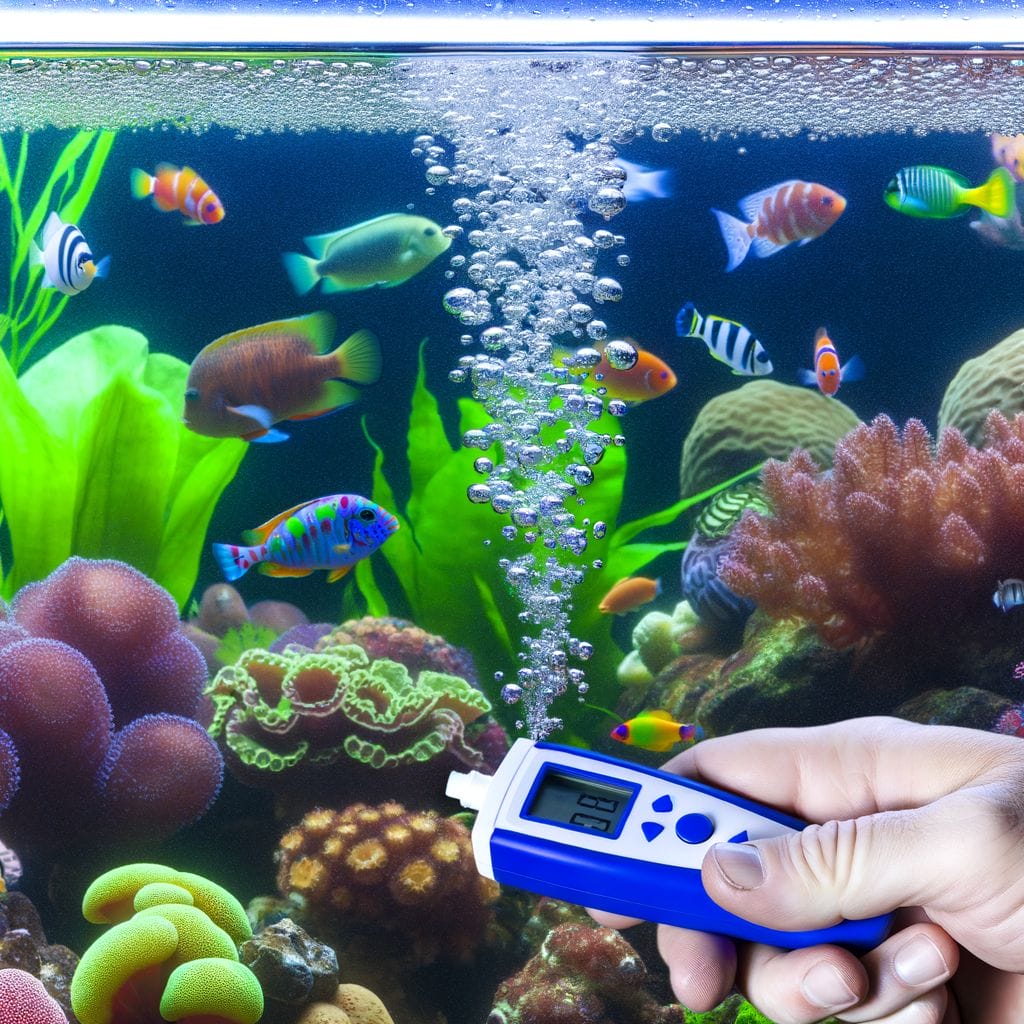
Now that you’re equipped with the knowledge of testing oxygen levels, let’s identify the signs that indicate low oxygen in your fish tank. Recognising signs of low oxygen in a fish tank is crucial to ensure the health and wellbeing of your aquatic buddies. To do this, one would need to test the water for dissolved oxygen.
One of the most visible signs is if your fish are gasping for air at the surface. This is a clear indication that the dissolved oxygen in the aquarium is insufficient. Another sign to look out for is the behaviour of your fish. If the fish in your aquarium are less active or swimming slower than usual, it’s time to check the oxygen levels as fish may be affected by low oxygen levels.
Plants too can give you clues. If you notice a decrease in the growth rate or wilting leaves, your tank might be low on oxygen – this is a sign the plants are affected by low oxygen levels. Moreover, changes in the water condition of your aquarium, like murkiness or unusual smells, could also signal a deficiency in oxygen content.
Here’s a handy table summarising the signs:
| Signs | Indications |
|---|---|
| Fish gasping | Low dissolved oxygen |
| Sluggish fish | Low oxygen levels |
| Plant decline | Oxygen deficiency in tank |
Methods to Test Oxygen Levels in Your Aquarium
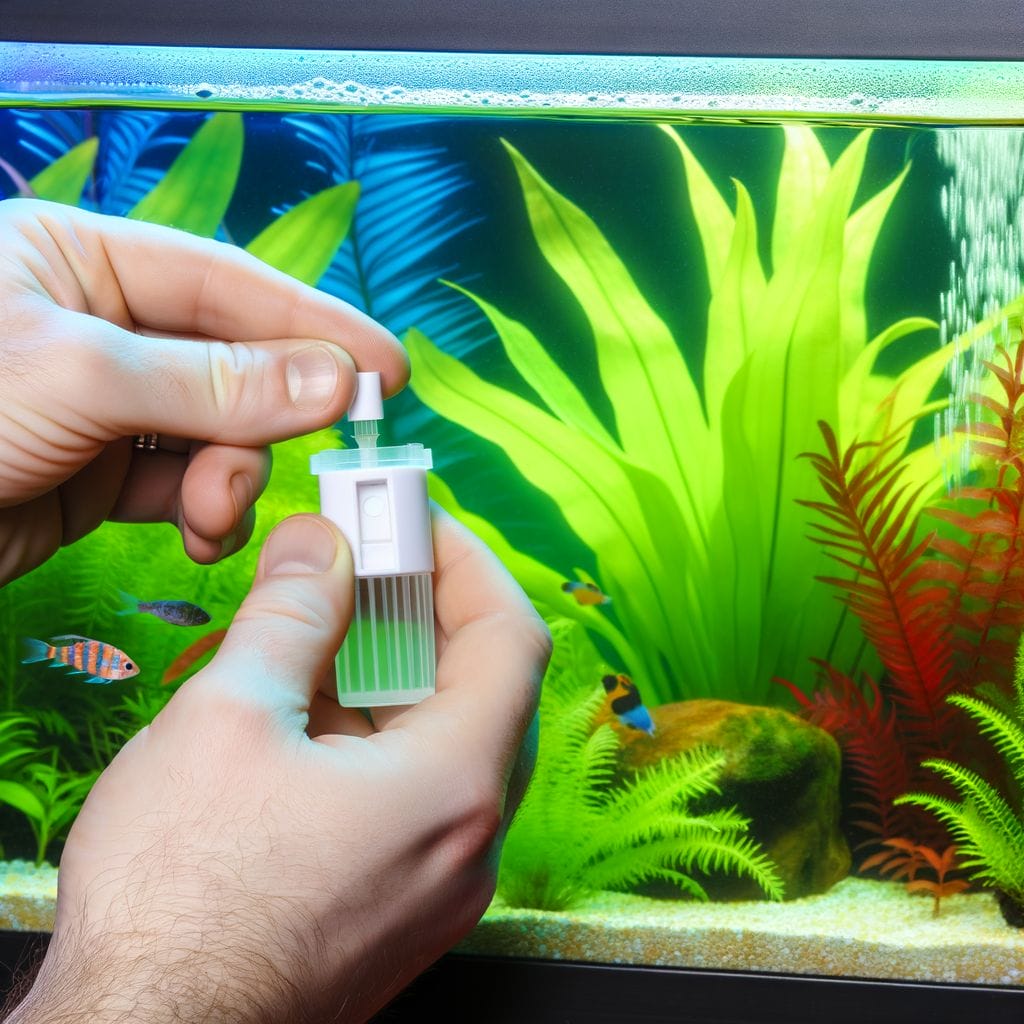
Regularly testing the oxygen levels in your aquarium is crucial, and there are several methods you can use to get accurate readings. Keeping an eye on the oxygen levels in a fish tank is key to providing a healthy environment for your aquatic friends.
- Oxygen test kit: The first method involves using an oxygen test kit. Aquarium test kits are simple to use, affordable, and can give you a quick overview of the oxygen levels in your tank. It’s like having your own mini laboratory at home, and you’re in full control. However, they may not be as accurate as other methods.
- Dissolved Oxygen Meter: A more precise method is using a dissolved oxygen meter. These devices provide a digital reading of the amount of dissolved oxygen in your tank, giving you a real-time insight into the health of your aquarium. They’re like your constant tank guardians, monitoring the oxygen in your aquarium, but they come at a higher price.
- Visual test: Lastly, visually assessing the behavior of your fish can be a good indicator of oxygen levels. If your fish are gasping at the surface, it’s a sign of low oxygen.
Causes and Solutions to Low Oxygen Levels in an Aquarium
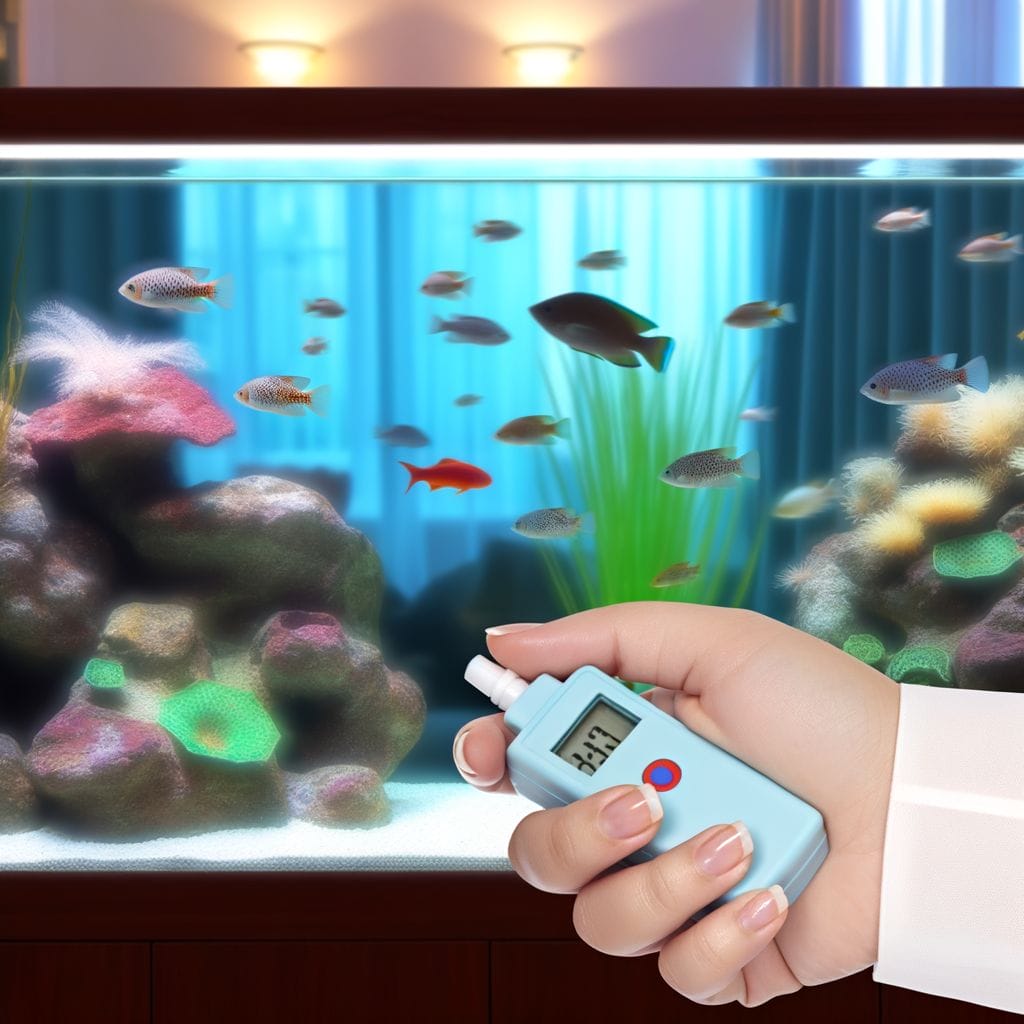
While you’re diligently monitoring the oxygen levels in your aquarium, it’s equally important to understand what causes these levels to drop and how to effectively address these issues. Low dissolved oxygen level in aquarium water is a common cause of low oxygen levels in fish. It’s often caused by overstocking the tank, high water temperatures, lack of water movement, and the presence of excess waste or chemicals in the water.
To check the oxygen in the water, you can use a dissolved oxygen test kit. If levels are low, you have several options to increase them. One of the most effective ways is aeration, which increases the movement of water and thus promotes the exchange of oxygen.
Here’s a handy table to help you identify causes and solutions:
| Cause of Low Oxygen Levels | Solution |
|---|---|
| Overstocking | Adhere to stocking guidelines |
| High water temperature | Use cooler water for changes |
| Lack of water movement | Increase water agitation |
| Presence of chemicals/waste | Regularly clean the aquarium |
Which Is More Important for Maintaining Oxygen Levels in an Aquarium: Using an Air Pump or a Filter?
When considering the difference between air pump and filter for maintaining oxygen levels in an aquarium, both play important roles. An air pump adds oxygen to the water by creating surface agitation, while a filter helps to keep the water clean and free of debris, allowing oxygen exchange to occur more efficiently.
Maintaining Ideal Oxygen Levels in Your Aquarium
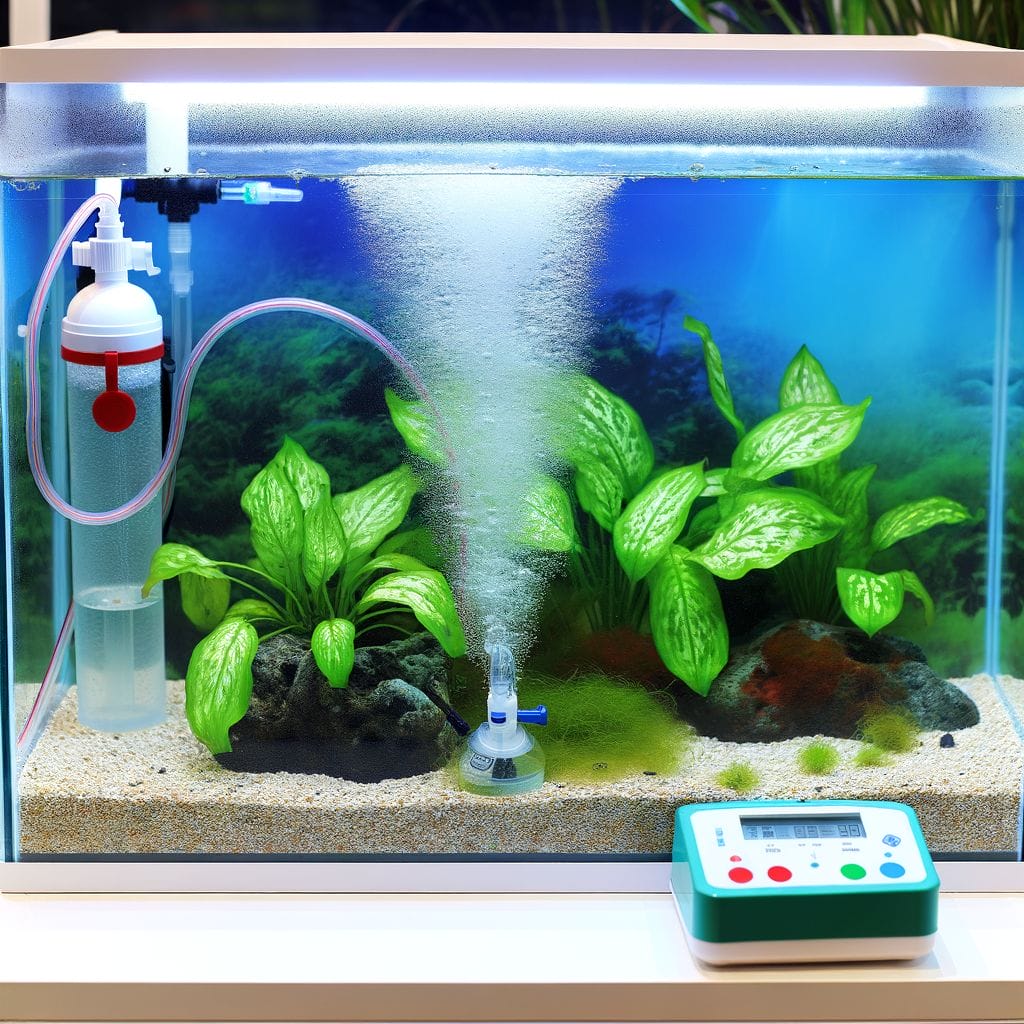
Ever wondered how to keep your aquarium’s oxygen levels in the ideal range? It’s easier than you might think, and it all starts with understanding the basics.
- Invest in a quality dissolved oxygen test kit. This will allow you to monitor the oxygen levels in your freshwater aquarium accurately. Remember, your fish are depending on you for their survival, and ensuring the right oxygen level is paramount to their health and happiness.
- Perform regular water changes. This not only helps maintain oxygen levels in your tank but also removes harmful toxins. You’ll be amazed at how a simple water change in your aquarium can revitalize your aquatic buddies, as it can increase the amount of oxygen water can hold, and restore the vibrancy in your tank.
- Embrace the freedom of choice: Choose fish species that are well-adapted to your aquarium setting. Some fish require more oxygen than others, and certain aquarium water can’t hold as much oxygen content, so choose wisely.
- Take control of the oxygen in your aquarium: Use air stones or water pumps to enhance water movement and increase oxygen. By creating your own currents, you’re simulating a natural, free-flowing environment that your fish will love.
- Be creative: Add live plants. They produce oxygen during the day, contributing to a well-balanced ecosystem in your tank.
Conclusion
So, there you have it! Keeping tabs on your aquarium’s oxygen levels is key to a healthy aquatic environment.
By recognizing signs of low oxygen, testing regularly, and understanding causes, you can tackle any issue head-on.
Remember, maintaining optimal oxygen isn’t just about equipment but also about careful stock management and use of chemicals.
Keep your fish happy and healthy by staying informed and proactive.
Your aquatic friends are counting on you!
Frequently Asked Questions
How do I test the oxygen levels in my aquarium?
You can test the oxygen levels in your aquarium by using a portable dissolved oxygen meter or through a way to test the amount of dissolved oxygen in the water.
Why is it important to test the oxygen levels in an aquarium?
Testing the oxygen levels is important to ensure that your fish get enough oxygen to thrive and to prevent oxygen depletion, which can be harmful to aquatic life.
What are the causes of low oxygen in an aquarium?
The causes of low oxygen in an aquarium can include overstocking with too many fish, warm water which can hold less oxygen, and inadequate surface agitation to increase the oxygen levels.
How can I increase the oxygen levels in my aquarium?
You can increase the oxygen levels in your aquarium by adding air stones or increasing the water movement to promote greater oxygen exchange at the surface of the water.
Do fish need a lot of oxygen in the tank?
Yes, fish need enough oxygen to survive, and the level of dissolved oxygen in the water directly affects the well-being of the aquatic inhabitants.



